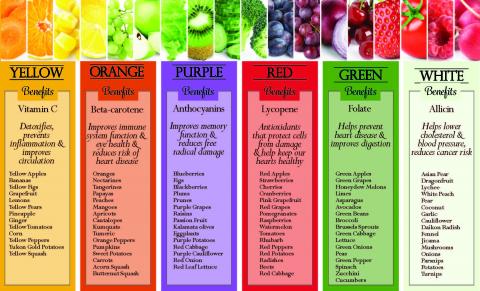Eating an assortment of colorful fruits, vegetables can help commissary customers get complete range of needed vitamins, minerals

FORT LEE, Va. – It’s no secret that eating five to eight servings of fruit and vegetables daily has immense health benefits. However, varying the colors you eat in those servings helps achieve maximum nutrition.
That’s the advice from Deborah Harris, registered dietitian and health and wellness program manager at the Defense Commissary Agency. “The local commissary and the agency’s website www.commissaries.com are valuable resources to help service members and their families choose colorful ingredients to get the most nutrients from the foods they eat while making the most of their commissary benefit,” she said.
Each color in fruits and vegetables indicates an abundance of specific nutrients. Eating an assortment of colorful foods can be an easy way to get a complete range of the vitamins and minerals your body needs.
Here are the unique nutrients of each color:
- Yellow: Rich in vitamin C which helps with circulation, detoxification and inflammation. Examples include yellow apples, bananas, grapefruit, corn and yellow squash and peppers.
- Orange: Contains beta-carotene that helps to improve immune system function, eye health and may reduce the risk of heart disease. Examples include oranges, peaches, cantaloupe, sweet potatoes and carrots.
- Purple: Anthocyanins, natural plant pigments that produce a rich purple color, help improve memory function and may reduce free radical damage to the body’s cells. Foods rich in these properties include blackberries, plums, prunes, blueberries, eggplant and red cabbage.
- Red: A good source of the antioxidant lycopene that promotes protection of cells. Studies have shown it is beneficial to heart health. Red apples, strawberries, watermelon, tomatoes, beets and red potatoes are good sources.
- Green: Rich in folate, these fruits and vegetables promote heart health and has been known to improve digestion. Examples are green apples, kiwi, green grapes, honeydew melon, broccoli, avocado, zucchini, celery, and leafy greens.
- White: Containing allicin, white produce helps lower cholesterol and blood pressure and may reduce the risk of cancer. White peaches, pears, coconut, onions, mushrooms, cauliflower, and white corn are good sources.
“When shopping for produce, be conscious of the health benefits of each color, filling your basket with your favorites, remembering that frozen and canned vegetables count too, “said Harris. “Then use the Nutrition Guide Program to find nutritious products in the center aisles to round out your menu. Look for items with the ‘Thumbs Up’ icon which identifies products with the highest nutrition quality, free of empty calories from added sugar and unhealthy fat, and low in sodium. The payoff to your health and wellness will be significant.”
Use the infographic as a resource when planning your weekly menu to ensure you incorporate a variety of color. Then visit commissaries.com and click on the healthy living link for dietitian-approved recipes, tips and links to assist you in meeting your health and wellness goals, and for help with planning meals.
-DeCA-
About DeCA: The Defense Commissary Agency operates a worldwide chain of commissaries providing groceries to military personnel, retirees and their families in a safe and secure shopping environment. Commissaries provide a military benefit, saving authorized patrons thousands of dollars annually on their purchases compared to similar products at commercial retailers. The discounted prices include a 5-percent surcharge, which covers the costs of building new commissaries and modernizing existing ones. A core military family support element, and a valued part of military pay and benefits, commissaries contribute to family readiness, enhance the quality of life for America’s military and their families, and help recruit and retain the best and brightest men and women to serve their country.
